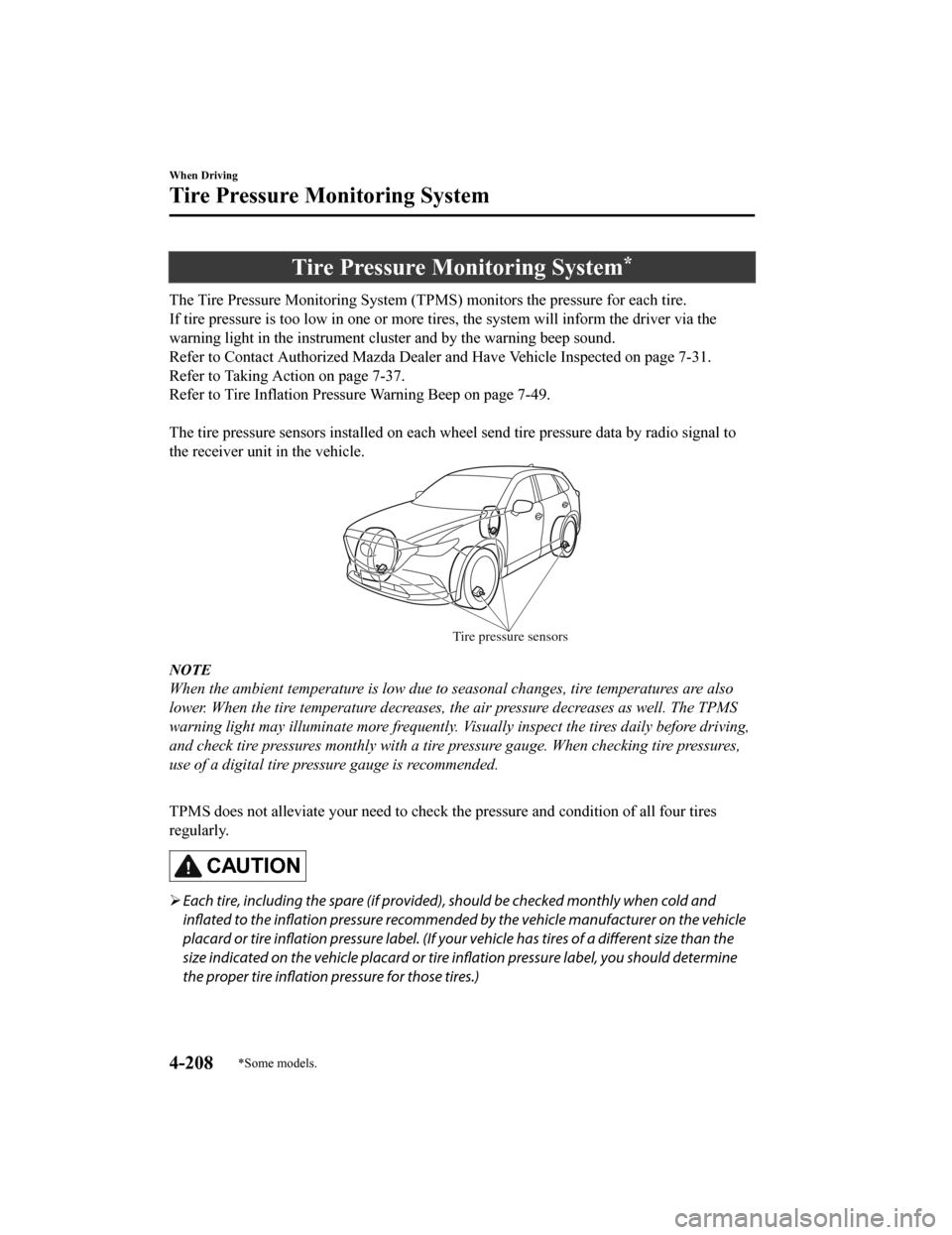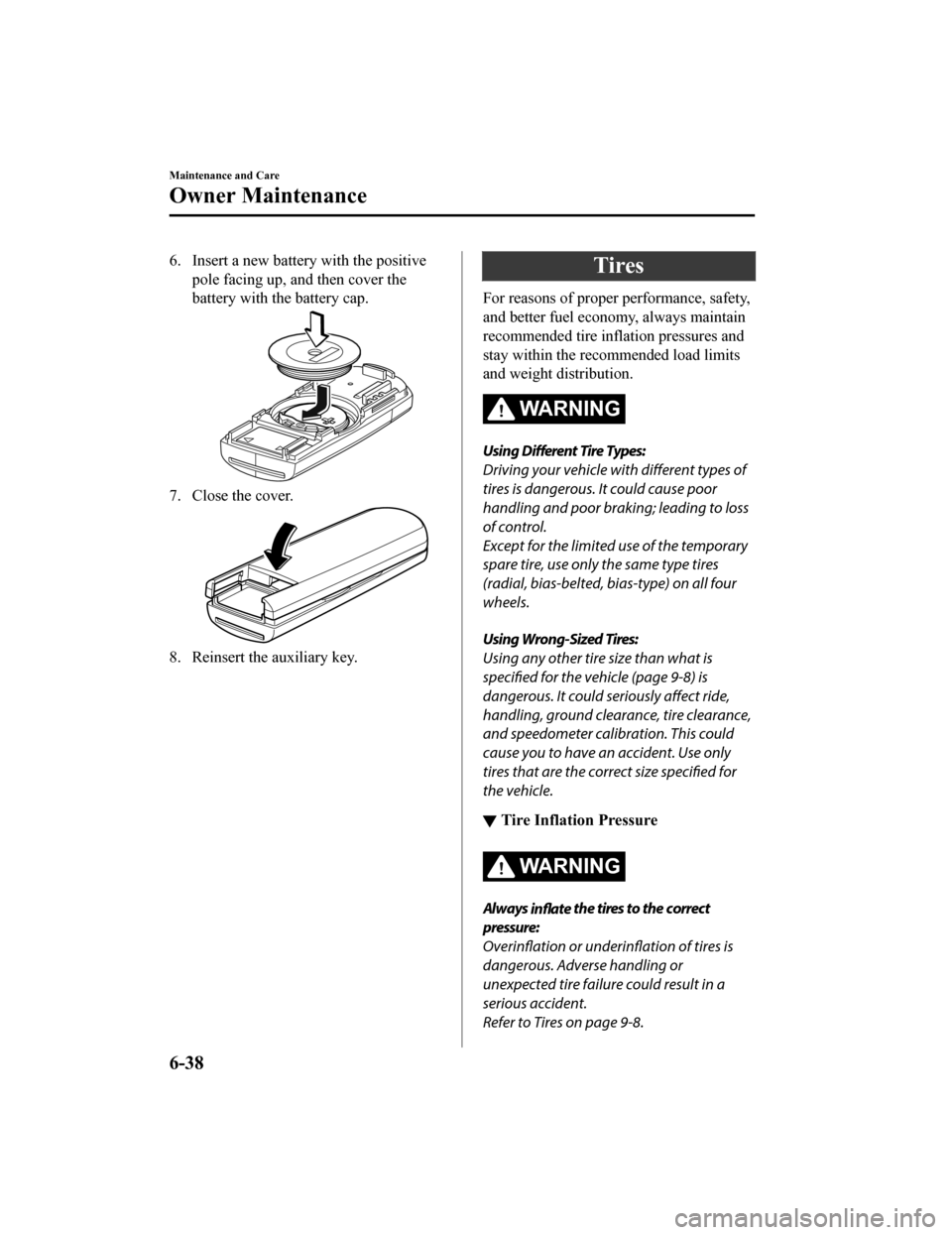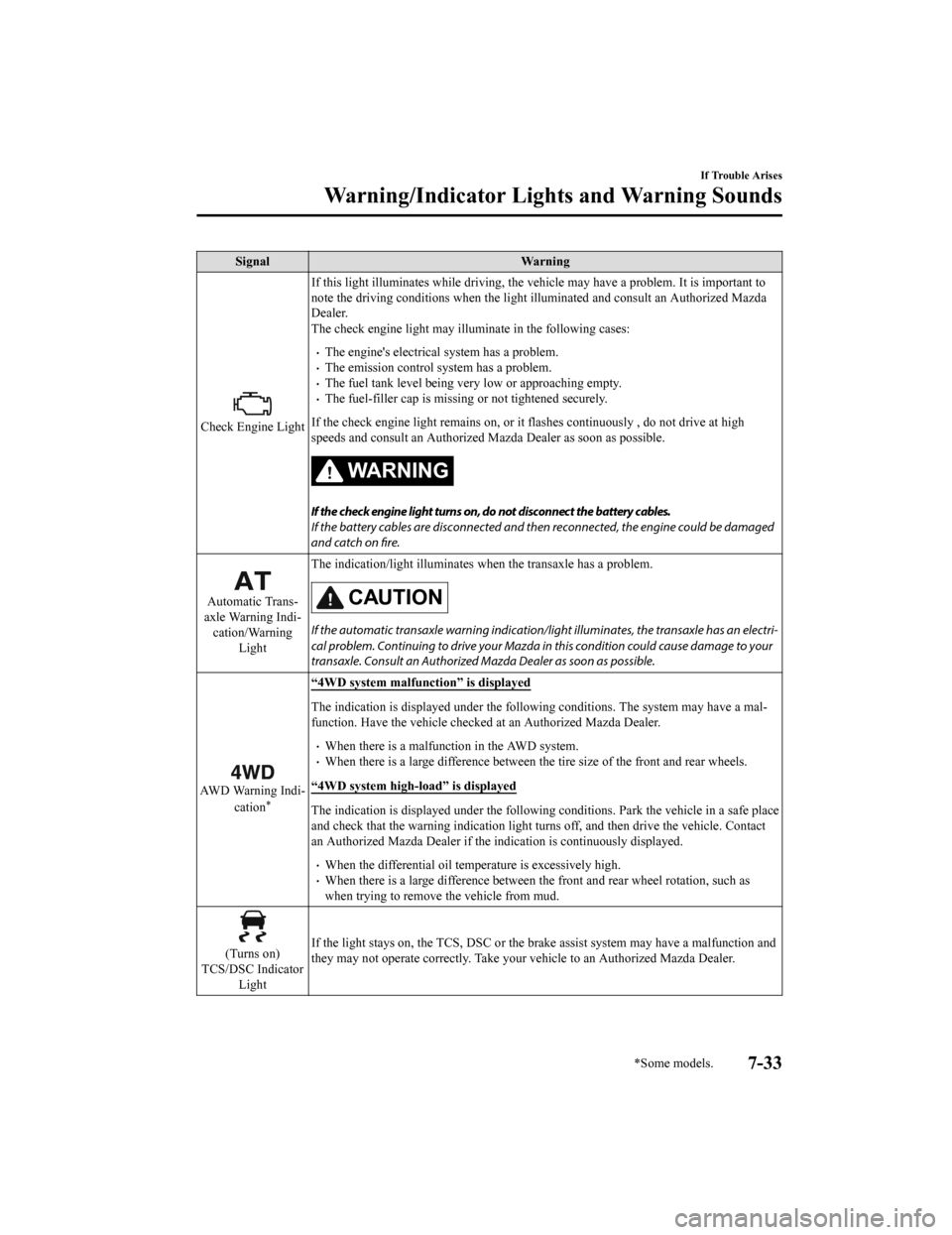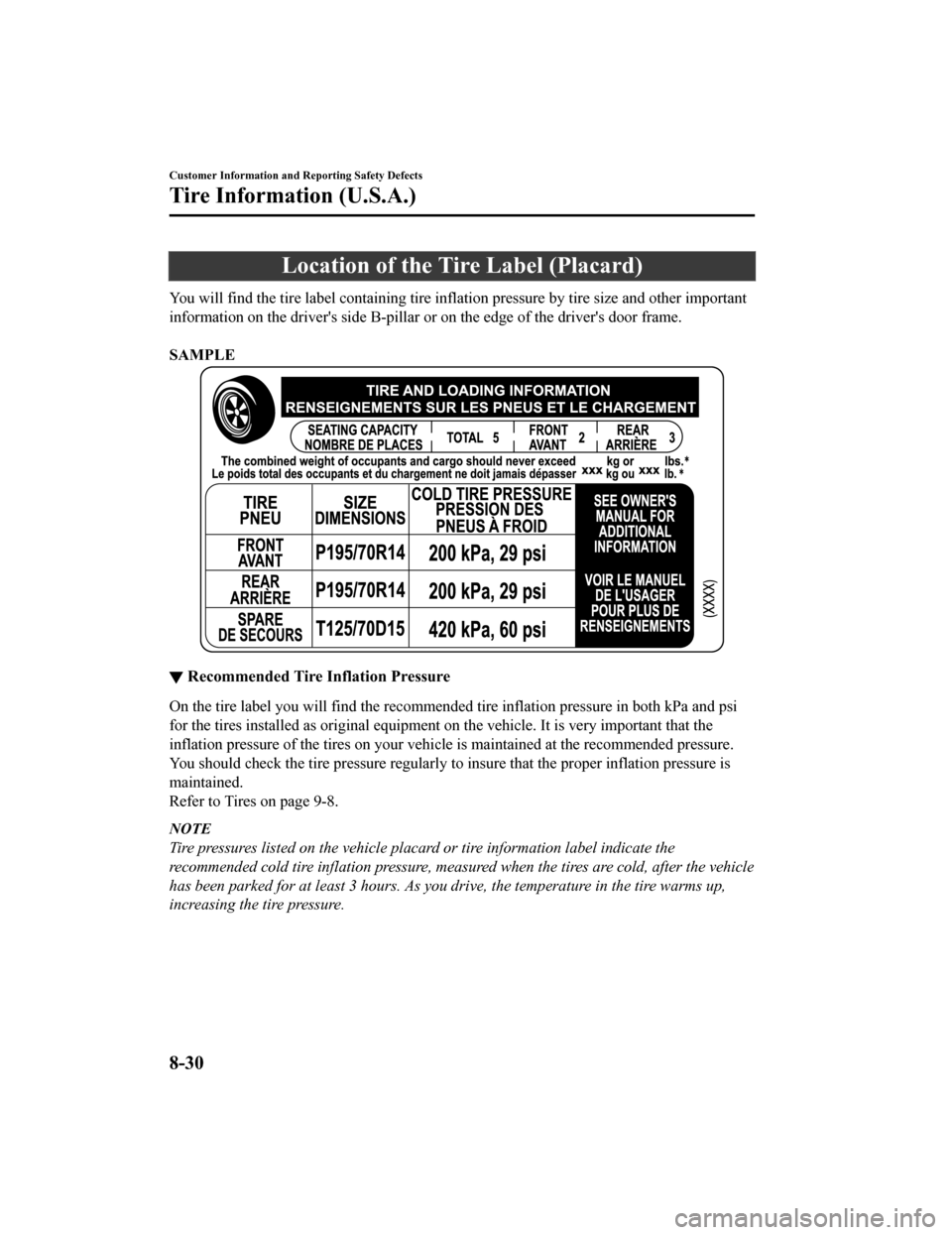tire size MAZDA MODEL CX-9 2019 (in English) User Guide
[x] Cancel search | Manufacturer: MAZDA, Model Year: 2019, Model line: MODEL CX-9, Model: MAZDA MODEL CX-9 2019Pages: 692
Page 368 of 692

Tire Pressure Monitoring System*
The Tire Pressure Monitoring System (TPMS) monitors the pressure for each tire.
If tire pressure is to o low in one or more tires, the system will inform the driver via the
warning light in the instrument cluster and by the warning beep sound.
Refer to Contact Authorized Mazda Dealer and Have Vehicle Inspected on page 7-31.
Refer to Taking Action on page 7-37.
Refer to Tire Inflation Pressu re Warning Beep on page 7-49.
The tire pressure sensors installed on each wheel send tire pre ssure data by radio signal to
the receiver unit in the vehicle.
Tire pressure sensors
NOTE
When the ambient temperature is low due to seasonal changes, tire temperatures are also
lower. When the tire temperature decreases, the air pressure decreases as well. The TPMS
warning light may illumina te more frequently. Visually inspect the tires daily before driving,
and check tire pressures monthly with a tire pressure gauge. When checking tire pressures,
use of a digital tire pressure gauge is recommended.
TPMS does not alleviate your need to check the pressure and con dition of all four tires
regularly.
CAUTION
Each tire, including the spare (if provided), should be checked monthly when cold and
inflated to the inflation pressure recommended by the vehicle manufacturer on the vehicle
placard or tire inflation pressure label. (If your vehicle has tires of a different size than the
size indicated on the vehicle placard or tire in flation pressure label, you should determine
the proper tire inflation pressure for those tires.)
When Driving
Tire Pressure Monitoring System
4-208*Some models.
CX-9_8HB2-EA-18G_Edition1 2018-5-11 13:09:27
Page 532 of 692

6. Insert a new battery with the positivepole facing up, and then cover the
battery with the battery cap.
7. Close the cover.
8. Reinsert the auxiliary key.
Tires
For reasons of proper performance, safety,
and better fuel economy, always maintain
recommended tire inflation pressures and
stay within the recommended load limits
and weight distribution.
WA R N I N G
Using Different Tire Types:
Driving your vehicle with different types of
tires is dangerous. It could cause poor
handling and poor braking; leading to loss
of control.
Except for the limited use of the temporary
spare tire, use only the same type tires
(radial, bias-belted, bias-type) on all four
wheels.
Using Wrong-Sized Tires:
Using any other tire size than what is
specified for the vehicle (page 9-8) is
dangerous. It could seriously affect ride,
handling, ground clearance, tire clearance,
and speedometer calibration. This could
cause you to have an accident. Use only
tires that are the correct size specified for
the vehicle.
▼ Tire Inflation Pressure
WA R N I N G
Always
inflate the tires to the correct
pressure:
Overinflation or
underinflation of tires is
dangerous. Adverse handling or
unexpected tire failure could result in a
serious accident.
Refer to Tires on page 9-8.
Maintenance and Care
Owner Maintenance
6-38
CX-9_8HB2-EA-18G_Edition1 2018-5-11 13:09:27
Page 535 of 692

The temporary spare tire is easier to
handle because of its construction which is
lighter and smaller than a conventional
tire. This tire should be used only for an
emergency and only for a short distance.
Use the temporary spare tire only until the
conventional tire is repaired, which should
be as soon as possible.
Refer to Tires on page 9-8.
CAUTION
Do not use your temporary spare tire rim
with a snow tire or a conventional tire.
Neither will properly
fit and could
damage both tire and rim.
The temporary spare tire has a tread life
of less than 5,000 km (3,000 miles). The
tread life may be shorter depending on
driving conditions.
The temporary spare tire is for limited
use, however, if the tread wear
solid-band indicator appears, replace the
tire with the same type of temporary
spare (page 6-40).
NOTE
Tires degrade over time, even when they
are not being used on the road. It is
recommended that tires generally be
replaced when they are 6 years or older.
Heat caused by hot climates or frequent
high loading conditions can accelerate the
aging process. You should replace the
spare tire when you replace the other road
tires due to the aging of the spare tire. The
period in which the tire was manufactured
(both week and year) is indicated by a
4-digit number.
Refer to Tire Labeling on page 8-25.
▼ Replacing a Wheel
WA R N I N G
Always use wheels of the correct size on
your vehicle:
Using a wrong-sized wheel is dangerous.
Braking and handling could be affected,
leading to loss of control and an accident.
CAUTION
A wrong-sized wheel may adversely
affect:
Tire
fit
Wheel and bearing life
Ground clearance
Snow-chain clearance
Speedometer calibration
Headlight aim
Bumper height
Tire Pressure Monitoring System
*
NOTE
When replacing a wheel, make sure the
new one is the same as the original
factory wheel in diameter, rim width,
and offset (inset/outset).
For details, contact an Authorized
Mazda Dealer.
Proper tire balancing provides the best
riding comfort and helps reduce tread
wear. Out-of-balance tires can cause
vibration and uneven wear, such as
cupping and flat spots.
Maintenance and Care
Owner Maintenance
*Some models.6-41
CX-9_8HB2-EA-18G_Edition1 2018-5-11 13:09:27
Page 569 of 692

Changing a Flat Tire
NOTE
If the following occurs while driving, it
could indicate a flat tire.
Steering becomes difficult.
The vehicle begins to vibrate
excessively.
The vehicle pulls in one direction.
If you have a flat tire, drive sl owly to a
level spot that is well off the road and out
of the way of traffic to change the tire.
Stopping in traffic or on the shoulder of a
busy road is dangerous.
WA R N I N G
Be sure to follow the directions for
changing a tire:
Changing a tire is dangerous if not done
properly. The vehicle can slip off the jack
and seriously injure someone.
No person should place any portion of their
body under a vehicle th at is supported by a
jack.
Never allow anyone inside a vehicle
supported by a jack:
Allowing someone to remain in a vehicle
supported by a jack is dangerous. The
occupant could cause the vehicle to fall
resulting in serious injury.
NOTE
Make sure the jack is well lubricated
before using it.
1. Park on a hard, le vel surface off the
right-of-way and firm ly set the parking
brake.
2. Shift into Park (P ) and turn off the
engine.
3. Turn on the hazard warning flasher.
4. Have everyone get out of the vehicle and away from the vehicle and traffic.
5. Remove the jack, tool, and spare tire (page 7-3).
6. Block the wheel diagonally opposite the flat tire. When blocking a wheel,
place a tire block both in front and
behind the tire.
NOTE
When blocking a tire, use rocks or
wood blocks of sufficient size if
possible to hold the tire in place.
▼Removing a Flat Tire
WA R N I N G
When jacking-up a vehicle, always shift the
selector lever to P, apply the parking brake,
and place wheel blocks in the position
diagonally opposed to the jack:
Changing a
flat tire without using wheel
blocks is dangerous because the vehicle
may move and fall off the jack even with
the select lever is in P, which could result in
an accident.
If Trouble Arises
Flat Tire
7-9
CX-9_8HB2-EA-18G_Edition1 2018-5-11 13:09:27
Page 593 of 692

SignalWarning
Check Engine LightIf this light illuminates while dr
iving, the vehicle may have a problem. It is important to
note the driving conditions when the light illuminated and cons ult an Authorized Mazda
Dealer.
The check engine light may illumi nate in the following cases:
The engine's electrical system has a problem.The emission control system has a problem.The fuel tank level being very low or approaching empty.The fuel-filler cap is missing or not tightened securely.
If the check engine light remains on, or it flashes continuously , do not drive at high
speeds and consult an Authorized Mazda Dealer as soon as possible.
WA R N I N G
If the check engine light turns on, do not disconnect the battery cables.
If the battery cables are disconnected and then reconnected, the engine could be damaged
and catch on fire.
Automatic Trans‐
axle Warning Indi‐ cation/Warning Light The indication/light illuminates
when the transaxle has a problem.CAUTION
If the automatic transaxle warning indication/ light illuminates, the transaxle has an electri‐
cal problem. Continuing to drive your Mazda in this condition could cause damage to your
transaxle. Consult an Authorized Mazda Dealer as soon as possible.
AWD Warning Indi‐
cation*
“4WD system malfunction” is displayed
The indication is displayed under the following conditions. The system may have a mal‐
function. Have the vehicle checked at an Authorized Mazda Deale r.
When there is a malfunction in the AWD system.When there is a large difference between the tire size of the front and rear wheels.
“4WD system high-load” is displayed
The indication is displayed unde r the following conditions. Park the vehicle in a safe place
and check that the warning indi cation light turns off, and then drive the vehicle. Contact
an Authorized Mazda Dealer if th e indication is continuously displayed.
When the differential oil temp erature is excessively high.When there is a large difference between the front and rear whe el rotation, such as
when trying to remove the vehicle from mud.
(Turns on)
TCS/DSC Indicator Light If the light stays on, the TCS, DSC or the brake assist system may have a malfunction and
they may not operate correctly.
Take your vehicle to an Authori zed Mazda Dealer.
If Trouble Arises
Warning/Indicator Lights and Warning Sounds
*Some models.7-33
CX-9_8HB2-EA-18G_Edition1 2018-5-11 13:09:27
Page 596 of 692

SignalWarning
Blind Spot Monitor‐
ing (BSM) OFF In‐
dicator Light
*
A problem in the system may be indicated under the following co nditions.
Have your vehicle inspected at an Authorized Mazda Dealer.
The light does not tur n on when the ignition is switched ON.The light remains on even when the Blind Spot Monitoring (BSM) system can be oper‐
ated.
It turns on while driving the vehicle.
NOTE
If the vehicle is driven on a road with less traffic and few vehicles that the radar sensors
can detect, the system may pause (The Blin d Spot Monitoring (BSM) OFF indicator light
in the instrument cluster illuminates). Ho wever, it does not indicate a malfunction.
(Amber)
Mazda Radar Cruise
Control with Stop &
Go function
(MRCC with Stop
& Go function)
Warning Indication
*
The message is displayed when the system has a malfunction. Have your vehicle inspect‐
ed at an Authorized Mazda Dealer.
Lane-keep Assist System (LAS) & Lane Departure
Wa r n i n g S y s t e m
(LDWS) Warning
Indication
*
The message is displayed when the system has a malfunction. Have your vehicle inspect‐
ed at an Authorized Mazda Dealer.
The system does not operate when the warning message is displayed.
CAUTION
Always use tires for all wheels that are of the specified size, and the same manufacture,
brand, and tread pattern. In ad dition, do not use tires with
significantly
different wear
patterns on the same vehicle. If such improper tires are used, the system may not operate
normally.
When an emergency spare tire is used, the system may not operate normally.
LED Headlight
Warning Light This light illuminates if there
is a malfunction in the LED hea dlight. Have your vehicle
inspected by an Authorized Mazda Dealer.
If Trouble Arises
Warning/Indicator Lights and Warning Sounds
7-36*Some models.
CX-9_8HB2-EA-18G_Edition1 2018-5-11 13:09:27
Page 638 of 692

P215/65R15 95H is an example of a tire size and load index rating. Here is an explanation
of the various components of tha t tire size and load index rating. Note that the tire size and
load index rating may be different from the example.
P
Indicates a tire that may be ins talled on cars, SUVs, minivans and light trucks as designated
by the Tire and Rim Association (T&RA).
NOTE
If your tire size does not begin with a letter this may mean it is designated by either ETRTO
(European Tire and Rim Technical Organization) or JATMA (Japan Tire Manufacturing
Association).
215
“215” is the nominal width of the tire in millimeters. This thr ee-digit number gives the
width in millimeters of the tire from sidewall edge to sidewall edge. In general, the larger
the number, the wider the tire.
65
“65” is the aspect ratio. This two-digit number indicates the t ire's ratio of height to width.
R
“R” is the tire construction symbol. R indicates “Radial ply co nstruction”.
15
“15” is the wheel rim diameter in inches.
95
“95” is the Load Index. This two-or three-digit number indicate s how much weight each tire
can support.
H
“H” is the speed rating. The speed rating denotes the maximum s peed for which the use of
the tire is rated.
Letter Rating Speed Rating
Q9 9 m ph
R1 06 m ph
S 112 mph
T 118 mph
U1 24 m ph
H1 30 m ph
Customer Information and Reporting Safety Defects
Tire Information (U.S.A.)
8-26
CX-9_8HB2-EA-18G_Edition1 2018-5-11 13:09:27
Page 640 of 692

Traction: The traction grades, from highe st to lowest are AA, A, B, and C. The grades
represent the tire's ability to stop on wet pavement as measure d under controlled conditions
on specified government test surfaces of asphalt and concrete. A tire marked C may have
poor traction performance.
Te m p e r a t u r e : The temperature grades are A (the highest), B and C, represent ing the tire's
resistance to the generation of heat and its ability to dissipa te heat when tested under
controlled conditions on a spec ified indoor laboratory test whe el.
Snow Tires
In some heavy snow areas, local governments may require true sn ow tires, those with very
deeply cut tread. These tires should only be used in pairs or p laced on all four wheels. Make
sure you purchase snow tires that are the same size and construction type as the other tires
on your vehicle.
SAFETY WARNING
The following safety warning a ppears on the tire's sidewall.
SERIOUS INJURY MAY RESULT FROM:
EXPLOSION OF TIRE/RIM ASSEMBLY DUE TO IMPROPER MOUNTING-MATCH
TIRE DIAMETER TO RIM D IAMETER; NEVER EXCEED 40 psi (275 kPa) TO SEAT
BEADS-ONLY SPECIALLY TRAINED PERSONS SHOULD MOUNT TIRES.
TIRE FAILURE DUE TO UNDER-INFLATION/OVERLOADING/
DAMAGE-FOLLOW OWNER'S MANUAL AND PLACARD IN
VEHICLE-FREQUENTLY CHECK INFLATION PRESSURE AND INSPECT FOR
DAMAGE.
▼ Information on Temporary Tires
Please refer to the sample below.
Customer Information and Reporting Safety Defects
Tire Information (U.S.A.)
8-28
CX-9_8HB2-EA-18G_Edition1
2018-5-11 13:09:27
Page 641 of 692

1. Temporary tires
2. Nominal width of tire in millimeters
3. Ratio of height to width (aspect ratio)
4. Diagonal
5. Rim diameter code
6. Load index & speed symbol
T115/70D16 90M is an example of a tire size and load index rating. Here is an explanation
of the various components of that tire size and load index rating. Note that the tire size and
load index rating may be different from the example.
T
Indicates a tire that may be installed on cars, SUVs, minivans and light trucks as designated
by the Tire and Rim Association (T&RA).
11 5
“115” is the nominal width of the tire in millimeters. This three-digit number gives the
width in millimeters o f the tire from sidewall edge to sidewall edge. In general, the larger
the number, the wider the tire.
70
“70” is the aspect ratio. This t wo-digit number indicates the t ire's ratio of height to width.
D
“D” is the tire construction symbol. D indicates “diagonal ply construction”.
16
“16” is the wheel rim diameter in inches.
90
“90” is the Load Index. This two-or three-digit number indicate s how much weight each tire
can support.
M
“M” is the speed rating. The speed rating denotes the maximum s peed for which the use of
the tire is rated.
Letter Rating Speed Rating
M8 1 m ph
Customer Information and Reporting Safety Defects
Tire Information (U.S.A.)
8-29
CX-9_8HB2-EA-18G_Edition1 2018-5-11 13:09:27
Page 642 of 692

Location of the Tire Label (Placard)
You will find the tire label containing tire inflation pressure by tire size and other important
information on the driver's side B-pillar or on the edge of the driver's door frame.
SAMPLE
▼ Recommended Tire Inflation Pressure
On the tire label you will find the recommended tire inflation
pressure in both kPa and psi
for the tires installed as orig inal equipment on the vehicle. I t is very important that the
inflation pressure of the tires on your vehicle is maintained a t the recommended pressure.
You should check the tire pressure regularly to insure that the proper inflation pressure is
maintained.
Refer to Tires on page 9-8.
NOTE
Tire pressures listed on the vehicle placar d or tire information label indicate the
recommended cold tire inflation pressure, measured when the tires are cold, after the vehicle
has been parked for at least 3 hours. As you drive, the temperature in the tire warms up,
increasing the tire pressure.
Customer Information and Reporting Safety Defects
Tire Information (U.S.A.)
8-30
CX-9_8HB2-EA-18G_Edition1 2018-5-11 13:09:27